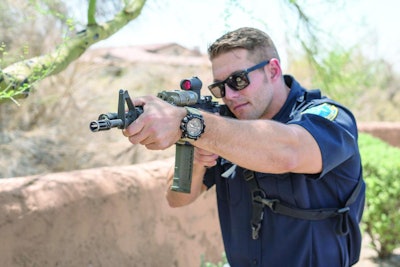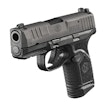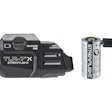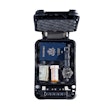 Photo: Franklin Rau/https://fsrau.smugmug.com
Photo: Franklin Rau/https://fsrau.smugmug.com
Last month POLICE conducted a survey on the use of lights, optics, and laser sights in law enforcement operations. The survey, which was open only to working law enforcement officers, yielded some interesting data on the tools in use today by police agencies.
In 1997 when two heavily armed bank robbers wearing bullet-resistant armor engaged dozens of Los Angeles police officers during the North Hollywood Shootout, the officers were armed with duty pistols and shotguns that were largely ineffective. That incident and 9/11 led to agencies issuing rifles to their patrol officers or allowing them to carry their own personal rifles on duty. Today, any bank robber in body armor shooting it out with police just about anywhere in the United States would be facing rifles.
Rifle Optics
And a lot of those police rifles would be fitted with optics to enhance officer accuracy. More than 73% of respondents to our survey said they have optics on their patrol rifles. A little more than 41% of officers who responded said their agencies actually issue optics for their patrol rifles.
Agencies and officers are willing to make a serious investment in optics for their rifles. More than a quarter of the officers responding to the survey said they spend $300 to $499 for their rifle optics. More than 9% said they spend as much as $750 for their duty rifle optics.
Weapon Lights
There was a time, not too long ago, when many agencies restricted the use of weapon lights to special units. SWAT officers had high-end weapon lights on their long guns and K-9 handlers had pistol lights so that they could light up targets with one hand while maintaining control over their dogs. Back then some agencies believed that patrol officers would point their pistols at people just to illuminate them, even when they had no justification to draw their weapons. Today, the use of weapon lights is becoming more common for officers of all assignments.
More than 70% of respondents to our survey said they have weapon lights on their duty rifles. On the pistol side, nearly 90% of officers said their agencies allow the use of weapon lights on their duty pistols and more than 68% said they have a weapon light on their duty pistol.
The majority, nearly 43%, of officers who responded to a question about what they paid for their rifle lights said the lights were actually issued by their agencies. Most officers pay less than $250 for their rifle lights, according to the respondents.
Our survey also yielded results that say police leaders are no longer worried about officers using their duty guns as flashlights when they aren’t justified in pointing a deadly weapon at someone. More than 40% of respondents said their agencies issue lights for duty pistols. Officers who buy their own duty pistol lights are likely to pay between $100 and $199, according to the respondents.
Laser Sights
Our survey shows that weapon lights and rifle optics are widely accepted in law enforcement. When it comes to laser sights and pistol optics, however, agencies are a little more restrictive.
Only 32% of respondents said their agencies allow them to use laser sights on duty. Even more revealing was what respondents said about using laser sights on duty: more than 87% said they do not use laser sights on duty.
But maybe agencies interested in reducing police use of deadly force should look into issuing officers laser sights. Of those who use laser sights, 16% said they have been able to deter an attack, de-escalate a confrontation, or persuade a suspect to surrender just by putting the laser dot on them.
We asked for the respondents’ stories of such confrontations, and they are fascinating. Here are some examples:
• “I found out you get approximately 80% compliance when advising the actors to follow commands when pointing the laser at center mass.”
• “I’ve had a number of encounters with people who have either attacked someone with a knife or were confronting me with a knife. Using my pistol’s red laser, I made it known I was prepared to shoot them and would hit them if I fired. All of these encounters ended peacefully.”
• “After a pursuit the driver wasn’t cooperative. When laser sight was used, he complied. He later remarked that he thought we wouldn’t miss if we shot at him.”
• “Excellent on felony stops. While the suspect is facing away, we shine the laser past them to get their attention and they comply more quickly. It also helps when holding one suspect at gunpoint while others are at large and I’m waiting on backup. I believe it has prevented an escalation in force on several occasions.”
• “I was confronted by a suspect with a folding knife who threatened to kill me and my partner. We both had pistol mounted lasers. The suspect noticed the red dots swimming on his chest and he seemed to wake up. He dropped the knife. Later he said he wanted to kill himself and wanted us to shoot him. But when he saw the laser dots, it became “real” for him and he changed his mind.”
Pistol Optics
The newest tool for law enforcement duty weapons is the pistol optic. These reflex sights are gaining acceptance in the consumer handgun market, as shown by the fact that nearly 50% of respondents in our survey said they have experience shooting handguns with optics.
But it may be some time before red dot optics for pistols become common on duty guns. Nearly 60% of respondents said their agencies do not permit officers to use optics on duty pistols.
Once again, agencies may want to reconsider that policy. Some 39% of respondents said they believed an optic on their duty pistol would make them a better shot in a gunfight. Currently, however, there are two major factors slowing the adoption of handgun optics in law enforcement: holster options are not plentiful and officers will need to be trained to properly shoot with the optic.
Our last weapon accessory question in the survey asked the respondents what they would like to see improved about optics, weapon lights, and laser sights. Of course, reducing the price was a very popular answer. One respondent even asked for special law enforcement pricing. But officers also mentioned a desire to make the devices more durable and upgradeable. For pistol optics, several respondents wanted to see more models with enclosed emitters because that would make them rugged enough to survive hard duty.














